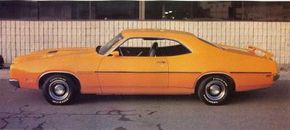The phrase "Mercury muscle cars" sounds like a contradiction in terms. Ford's upscale division, after all, was positioned to battle the Buicks and Oldsmobiles of the world.
But the youth market of the 1960s pulled a lot of automotive brands in directions they might not ordinarily have gone. And so by the later part of the decade, even staid Mercury had a respectable little muscle-car lineup.
Advertisement
That performance presence didn't quite come out of nowhere. Ford had taken care to include Mercury in its early-'60s hot-engine efforts. The speed-demon Mercury for '62 and '63 was the Marauder S-55 with the optional 405-bhp 406-cid Ford V-8. When Ford made its strong 427-cid V-8 available, Mercury got that, too. A full-fanged version Mercury Marauder X-100 was released in 1969.
Still, it was the Ford versions of these cars that got the lion's share of street-performance publicity. That was a bit ironic, since Mercury had fashioned a stalwart racing identity all its own.
Cale Yarborough was among the NASCAR greats who drove Mercurys to stock-car victories in the '60s. Mercury's drag-racing credentials were just as strong. "Dyno" Don Nicholson and Ronnie Sox were just two of the top quarter-milers who piloted Mercury Comet compacts.
Stock-class Comets cleaned up at the 1964 NHRA Winternationals, and Factory Experimental Comets were among the quickest and most advanced drag cars of the day. And Mercury's Cougar pony car was competitive in the SCCA's wildly popular Trans Am race series.
What street cred Mercury mustered centered on the Comet Cyclone GT, which had graduated to the midsize Fairlane chassis for 1966. It used mainly Ford's 390-cid V-8, which unfortunately was just as overmatched here as it was in the Fairlane.
Cougar had debuted for 1967 with the 390 as its biggest available engine and then upped its firepower for '68 with the Cougar GT-E, which came with a 390-bhp 427. The hottest Cougars and Cyclones soon adopted the new 428 Cobra Jet, and as the engine became Ford's flagship performance mill, late-'60s ads read "Lincoln-Mercury's zip code: CJ428."
By 1969, performance Mercurys were available with most of the bright colors, stripes, and body addenda that had become routine markers of American muscle. The 1969 and '70 Cougar Eliminator featured a stand-up rear-deck spoiler, prominent side stripes, and bright "Grabber" colors. It backed up its bold looks with the full slate of Ford performance V-8s, from the 290-bhp Boss 302 to the 335-bhp 428 CJ.
Mercury also fielded the Cyclone Spoiler and Spoiler II in 1969, complete with special-trim editions in the colors of racers Cale Yarborough and Dan Gurney.
Mercury's largest-displacement performance engine was Ford's familiar 370-bhp 429-cid Cobra Jet, introduced for 1970. The 1970 Cyclone Spoiler in which it appeared finally had distinct styling from that of the Ford Torino. With a full compliment of muscle hardware as standard equipment, this was best volume-production Mercury muscle car of the period, good for mid-14-seconds in the quarter-mile.
For those who couldn't afford the Spoiler, the Cyclone GT was Mercury's lower-priced alternative, with a 351 V-8 standard and the 429 optional.
When high performance fell out of fashion after 1971, Mercury wasted no time folding up its muscle-car tent. The division embraced the faux-luxury persona that swept Detroit in the 1970s. That may have pained the few buyers who looked to Mercury for a different-drummer sort of muscle car, but it really signaled a return to the marque's traditional mission.
Return to Muscle Car Information Library.
For more cool information on muscle cars, check out:
- Muscle cars came in many shapes and sizes. Here are features on more than 100 muscle cars, including photos and specifications for each model.
- Muscle cars created their own culture. To learn about it, read How Muscle Cars Work.
Advertisement
